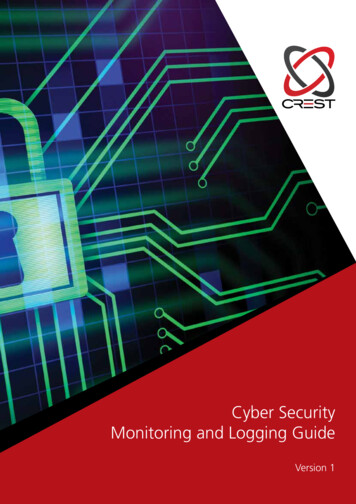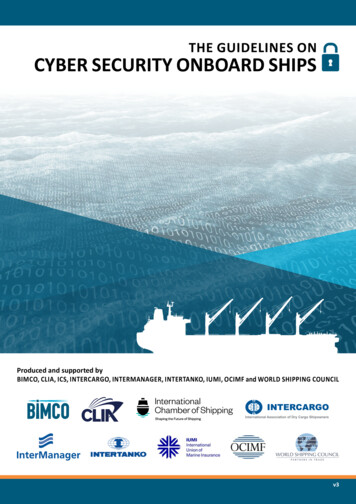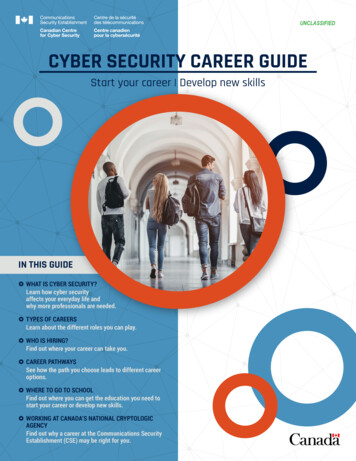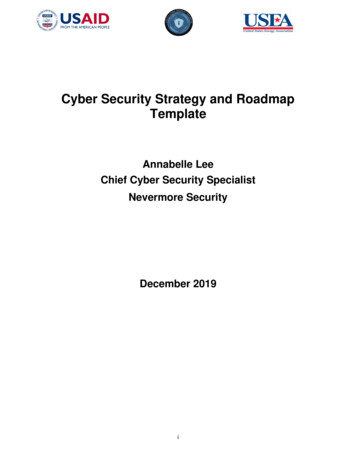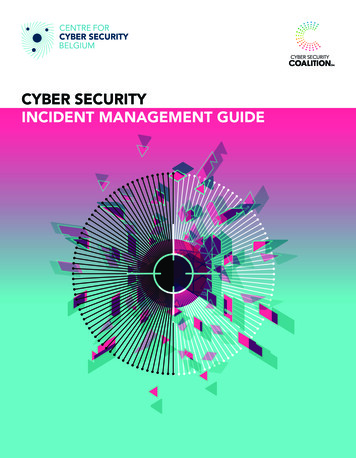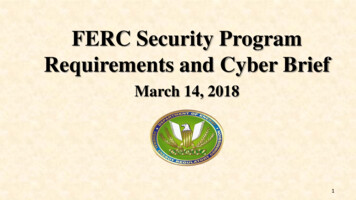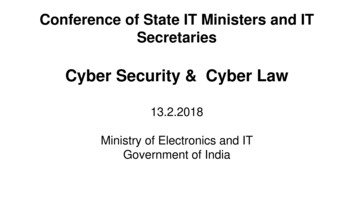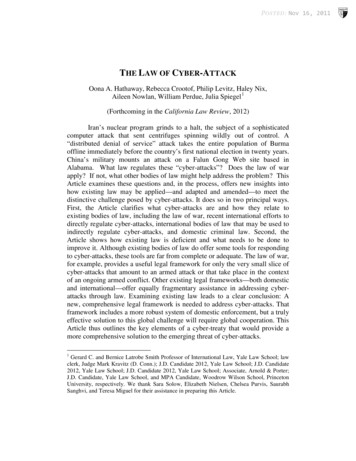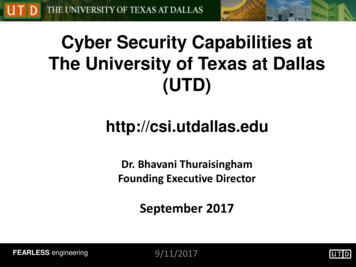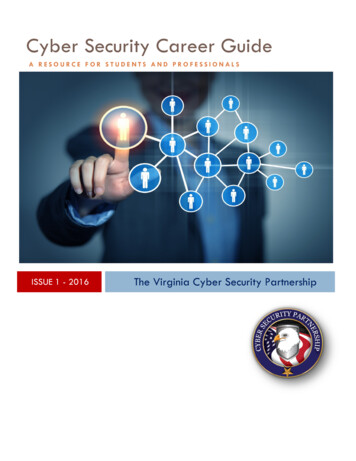
Transcription
Cyber Security Career GuideA RESOURCE FOR STUDENTS AND PROFESSIONALSISSUE 1 - 2016The Virginia Cyber Security Partnership
Cyber Security Career GuideCyber Security Career GuideA RESOURCE FOR STUDENTS AND PROFESSIONALSPREFACE . 3ABOUT THE VIRGINIA CYBER SECURITY PARTNERSHIP . 4PART 1 CAREERS IN CYBER SECURITY . 5INFORMATION ASSURANCE . 5SECURITY OPERATIONS . 5INTELLIGENCE ANALYSIS . 6RISK MANAGEMENT, AUDIT & COMPLIANCE . 7STRATEGIC PLANNING . 7DIGITAL FORENSICS . 8PART 2 CRITICAL TRAITS OF A CYBER PROFESSIONAL. 9INTEGRITY. 9TRUSTWORTHINESS . 9TEAM COMMITTMENT. 9PERSEVERANCE. 10EFFECTIVE COMMUNICATIONS . 10PART 3 CAREER DEVELOPMENT . 11VALUE-BASED CAREER DECISIONS . 113 DIMENSIONS OF DEVELOPMENT . 11DEVELOPMENT METHODS . 11PART 4 MENTORING . 12PURPOSE OF A MENTOR . 12CHOOSING A MENTOR . 12DEFINING THE MENTORING RELATIONSHIP . 12PART 5 CAREER DEVELOPMENT RESOURCES . 14CYBER COMPETITIONS . 14CERTIFICATIONS. 16INTERNSHIPS, SCHOLARSHIPS, POST-SECONDARY EDUCATION . 18SELF-STUDY . Error! Bookmark not defined.PART 6 REFERENCES AND RESOURCES. 19Page 1
Cyber Security Career GuidePage 2
Cyber Security Career GuidePREFACEAnswer this question. How many electronic devices are digitally connected in your home? Chances are youdon't actually know. You're not alone.As a society we have a tendency to adopt new technology faster than we can digest the risks they create.Technological advancements have created enormous opportunities for businesses and individuals to do thingsthat were once only considered science fiction. These same advancements, however, have changed the risklandscape and also created new opportunities for system exploitation. A different type of opportunity hasbeen created with these risks, --an opportunity to protect the interests of our country and society through thecyber security profession. If you're interested in learning more about a rewarding career that is high indemand, then this guide is for you.Over the last 10 years, few professions have grown as fast as cyber security. The demand for skilled andexperienced talent has increased exponentially as new, complex, and more sophisticated threats emerge. Asa result of a shortage in qualified professionals, the average cyber security professional currently earns over 100,000. To help put that in perspective, according to 2014 U.S. Census Bureau data, the average cybersecurity professional individually earns more than 75% of the combined household incomes in the United States.Due to the continued growth in demand for skilled cyber security professionals, the pipeline of securityprofessionals has not been able to keep up. By the year 2020 according to the 2015 (ISC)2 GlobalInformation Security Workforce Study, the shortage of professionals is expected to reach 1.5 million. InVirginia alone, the number of cyber security related jobs is expected to increase by 25% through 2022. In2014 Governor McAuliffe signed an Executive Order Launching “Cyber Virginia” and the Virginia CyberSecurity Commission to correct this shortage.The purpose of this guide is to help navigate the cyber security profession by providing useful insights andresources for anyone interested in entering the field of cyber security.Page 3
Cyber Security Career GuideABOUT THE VIRGINIA CYBERYBER SECURITY PARTNEPARTNERSHIPThe Virginia Cyber Security Partnership (VCSP) was founded in 2012 through astrategic collaboration with the Federal Bureau of Investigation (FBI) and cybersecurity leaders within the industry.The Partnership works with the FBI and the Commonwealth of Virginia to promotemutually beneficial information sharing, foster professional development, andconduct community outreach.The mission of the VCSP is to address the cyber security risks facing Virginia andour nation by establishing and maintaining a trusted community of public andprivate sector cyber professionals.Members of the VCSP include representatives from many of Virginia’s most respected organizations which enablescross industry insights for enhanced collaboration.The VCSP achieves its mission through the delivery of three primary mission objectives: Skill Enhancement, providing opportunities to sharpenexisting skillsets and develop new skills within cyber security.Outreach and Pipeline DevelopmentDevelopment, enhancing theawareness of cyberr security, and sharing opportunities withinthe cyber profession to expand the pipeline of skilledprofessionals to support the increased demand of cybersecurity programs.Collaboration,, fostering a community and strengthening theoverall program by creating opportunities for members tocollaborate on threat intelligence, best practices, and othercyber related activities.Page 4
Cyber Security Career GuidePART 1 CAREERS IN CYBER SSECURITYINFORMATION ASSURANCEInformation assurance is the practice of managing informationinformation-relatedrelated risks. More specifically, IA practitionersseek to protect and defend information and information systems by ensuring confidentiality, integrity,authentication, availability, and non-repudiation.pudiation. These goals are relevant whether the information is instorage, processing, or transit, and whether threatened by malice or accident. In other words, IA is the processof ensuring that authorized users have access to authorized information at ththee authorized time.EXAMPLE ROLES WITHIN INFORMATION ASSURANCEInformation Assurance Analysts apply current technologies to the design, development, evaluation andintegration of computer information systems and networks to maintain system security. These analystsaareresponsibleesponsible for ensuring the protection of company data against unauthorized disclosure, accidental orintentional loss of data, or unauthorized modification.Information Assurance Engineers oversee the storing and processing of information witwithinhin a company,company makingsure that it is secure. The engineer should also conduct period risk assessmentsassessments,, allowing them to detect anypotential risks that are present in order to minimize potential data breaches.Incident Responders are cyber firefighters, rapidly addressing security incidents and threats within anorganization as they occur. Using a wide range of computer forensic tools, ttheyhey discover the problem, mitigatethe damages, and take detailed notes throughout the entire process. Prior eexperiencexperience in computerinvestigations or general computer forensics is often necessarynecessary. Thehe ability to obtain security clearance issometimes also a requirement.SECURITY OPERATIONSSecurity Operations includes all of those functions required to ensure that a wide variety of technical securitycontrols are effectively and efficiently implemented, configured and maintained. Hands on design, selection,and administration of capabilitiesapabilities such as malware protection, web content filtering, network firewalls, remoteaccess, mail filtering, network packet capture, security information and event management, digital forensics,and whitelisting are typically included in security operations.EXAMPLE ROLES WITHIN SECURITY OPERATIONSSecurity Administrators are responsibleonsible for installing,administering, and troubleshooting an organization’ssecurity solutions, and are the point person for cybersecurity systems.Security Architects design, build, and oversee theimplementation of network and computer security for anorganization.Security Engineers sometimes called Network Engineers,build and maintain IT security solutions for an organization.Security Operations Center (SOC) Analysts are part of thePage 5
Cyber Security Career Guideteam that performs the day-to-dayday monitoring of an environment, analyzingalyzing and responding to events asnecessary, and providing technical support.Vulnerability Assessors also known as Vulnerability Assessment Analysts, scan applications and systems toidentify vulnerabilities.INTELLIGENCE ANALYSISIntelligence analysis is the process of taking known information about situations and entities of strategic,operational, or tactical importance, with appropriate statements of probability, assessing and characterizingfuture actions in those situations and by those entities. The descriptions are drawn from what may only beavailable in the form of deliberately deceptive information; the analyst must correlate the similarities amongdeceptions and extract a common truth.EXAMPLE ROLES WITHIN INTELLIGENCE ANALYSISIntelligence Analysts work for a variety of organizations,including federal government agencies, such as the FederalBureau of Investigation (FBI), National Security Agency (NSA),andnd Central Intelligence Agency (CIA), public sectororganizations such as the Virginia Fusion Center, the VirginiaInformation Technology Agency, as well as private sectorcompanies. The tasks involved in this line of work entailextensive research and collecting information from manysources. Intelligence analysts then sort, target, and identifyrelevant data, which is reported to key officials.Tactical Analysts provide up-to-the-minuteminute information about the specific threats that have already maturedorr are on the operational horizon. These analysts are often embedded with active investigations and provideinformation on the impending mission. They may assist in preparation for a mission as well as the gathering ofdata following successful operations, which may involve interrogations, technology analysis,analysis and crime sceneinvestigations.Collection and Reporting Analysts are handlers of raw intelligence. They manage intelligence gatheringmethodologies with the intent of improving accuracy and efficient collection. They often utilize linguists anddecryption technologies to decipher high priority intelligence that may help others better prepare for a missionor more quickly and effectively achieve success.Strategic Analysts assist in threat analysis, ppolicy formulation, and strategic resource application. Theseanalysts often use the processed information of others in order to generate comprehensive strategies thataddress and eliminate threats. These analysts use a big picture approach to organizatioorganizationalnal management,which enhances intelligence, criminal investigationsinvestigations, and national security operational performance.Security Analysts,, also known as threat aanalysts,nalysts, detect and prevent cyber threats to an organization. Theirresponsibilities are continuallynually expanding as the number of cyberattacks increases.Page 6
Cyber Security Career GuideRISK MANAGEMENT,, AUDIT & COMPLIANCERisk Management is the practice of identifying, assessing and managing risks to an organization’s mostimportant assets. Risks manifest themselves in many forms and may come from external threats, internalthreats, or pre-existing vulnerabilities that have the potential toimpact the confidentiality, integrity or availability of company dataand information systems. Risk analysis is used to determine theprobability of these risks impacting business operations andwhether or not the consequences are tolerable. When theprobability and consequences represent an unacceptable risk to thecompany, risk management methods are used to define andimplement cyber security controls to mitigate those risks to anacceptable level.Risk management may also include functions designeddesign to ensurecompliance with mandatory cyber security regulatory requirements or voluntarily adopted industry standards.These functions establish information security policies and design other managerial, technical and operationalcontrols. These controls in turn address specific performanceperformance-based objectives typically meant to secure aspecific group of assets,, either within an industry segment or across government organizations. Once controlsare established, audits are performed to validate that those controlsontrols are designed and implemented consistentwith their intended purpose.EXAMPLE ROLES WITHIN RISK MANAGEMENT, AUDIT & COMPLIANCESecurity Auditors assess the design and effectiveness of computer policies and programs and their relatedsecurity components typically against recognized standards or best practicespractices.Security Software Developers (Programmers)rogrammers) develop software used in the prevention or detection of cyberincidents. They also play a role with the integration of security into applications softwareware during the course ofdesign and developmentRisk Analysts evaluate how a company/organization operates its business to identify the physical assets (i.e.,facilities and equipment), and information assetassets (i.e., intellectual property and privacy information)information it considersmost important. Wherever the assets are vulnerable to specific threatsthreats, theyhey develop a plan to effectivelymanage and prudently invest in security measures that will mitigate the identified risk to the company.company Risksmitigation becomes part of an overall strategic plan.STRATEGIC PLANNINGStrategic planning is an organization's process of defining its strategy,or direction, and making decisions on allocating its resources to pupursuethis strategy. It may also extend to control mechanisms for guiding theimplementation of the strategy. Strategy has many definitions, butgenerally involves setting goals, determining actions to achieve thegoals, and mobilizing resources to execute these actions. A strategydescribes how the ends (goals) will be achieved by the means(resources). In cyber security, the process of strategic planning involvesdevelopment of strategies to manage information technology relatedPage 7
Cyber Security Career Guiderisks that fall outside thehe organization’s risk appetite.EXAMPLE ROLES IN STRATEGIC PLANNINGSecurity Managers,, sometimes called Security Directors, are expected to manage an organization’s IT securityin every sense of the word – from devising imaginative security solutions to implementing policies and trainingprocedures.Security Officers, like a Chief Information SecSecurity Officer (CISO), oversee allll operations and staff in any ITsecurity department.Security Managers and Officers are expected to have degrees in an associated field as well as extensiveexperience in information security and proven management skills.DIGITAL FORENSICSDigital forensics (sometimes known as digital forensic sciencescience) is a branch of forensic science,science whichencompasses the recovery and investigation of material found in digital devices, often in relation to computercrime. The term digital forensics was originally used as a synonym for computer forensics but has expanded tocover investigation of all devices capable of storing digital data.Digital forensics investigations have a variety ofapplications. The most common is to support orrefute a hypothesis before criminal or civil (as partof the electronic discovery process) courts. Forensicsmay also be used by private sector companiescompanies;such as during internal corporate investigatioinvestigations orintrusion investigation (a probe into the nature andextent of an unauthorized network intrusionintrusion).EXAMPLE ROLES IN DIGITAL FORENSICSComputer forensics investigators may provide many services, from investigating computer systems and datain order to present information for legal cases to determining how an unauthorized user hacked into a systemto gathering digital information that will assist in ththe termination of an employee. During the course of thesetasks, the digital forensics investigator pprotectsrotects the computer system, recovers all files (including those that weredeleted or password-protected),protected), analyzes all data found on various disks, and provides reports, feedback,and even testimony, when required.Forensics Experts,, also known as computer forensic analysts or investigators, are digital detectives, harvestingand analyzing evidence from computers, networks and other forms of data storage devices.Cryptanalysts analyze encrypted information to break the code/cipher or to determine the purpose ofmalicious software.Cryptographers,, also known as cryptologists, use encryption to secure information or to build security software.They also work as researchers to develop stronger encryption algorithmsPage 8
Cyber Security Career GuidePART 2 CRITICAL TRAITS OF A CYBER PRPROFESSIONALInformation security professionals are responsible for helping business leaders understand cybersecurity riskand how to properly mitigate such risk. In addition tounderstanding the multiple threats that faceorganizations today, an information securityprofessional must also understand the business of theirorganization. They need to differentiate andprioritize the risks of threats in relation to thesensitivity of their organization’s data. Ultimately theyhave to act as translators, being able to explaincyber threats and risks in non-technicaltechnical terms that canhelp business leaders make decisions to protect one oftheir most important assets, data.INTEGRITYIntegrity is the quality of being honest and having strong moral principles. It is generally a personal choice tohold oneself to consistent moral and ethical standards. Honesty and truthfulness of one's actions make up theintegrity of an information security professionalprofessional.TRUSTWORTHINESSCharacter is a function of all aspects of a person’s behavior and attitattitudes. Trustworthiness is one charactertrait that is an essential foundation for any cyber security jobjob. When employers and coworkers assesstrustworthiness, they base their assessment on competence and credibility. As an example of trustworthiness, aninformation security professional may be charged with safeguarding highly sensitive information involvinginvolvin anorganization’s data breach or an investigation of data theft and misuse by internal employees. Competencerequires an ability to execute assigned tasks in such a way that allows them to trust that you’ll correctly andefficiently perform the task. Credibilityredibility means that you can be counted on to complete your assignments whilealso maintaining strict confidentiality. Demonstrating you are competent and credible helps to build trust.TEAM COMMITTMENTTeamwork is fundamental to confronting the cyber securitycurity risks facing private and public sector organizations.Strong collaboration within and between these organizations is essential to mounting a meaningful response togrowing and evolving cyber threats.Becauseecause cyber threats are sophisticated and complex,defending and mitigating these threats requires a varietyof skills and functions. Each must work together towards acommon objective. Information security professionals mustwork for collaboration and cooperation with teams in bothtechnology and the business.Cyber security professionals must also build strongrelationships within their organization and with a widePage 9
Cyber Security Career Guidevariety of industry and government partners in order to have a head start against cyber threats.threatsPERSEVERANCEThe practice off information security is hard. Systems and software being protected change frequently. Threatsoften evolve faster than new controls can be implemented tomitigate those threats. Cyber threat analysis can be tediousand take time to determine the right solution to combat threatsagainst your organization. In addition, ssecurity policies viewedas necessary by a cyber security professional may be seen asobstacles to the mission of their colleagues across organizationand are sometimes met with resistance. These are just a few ofthe many difficulties associated with mitigating security risksrisks.Cyber security professionals must always be steadfast in theirefforts to achieve and maintain a strong security postureposture, inspite of the many challenges they will face along the wayway.EFFECTIVE COMMUNICATIONSInformation security isn’t about being in control. It’s about helpingbusiness leaders make wise decisions based on their knowledge of thebusiness environment and market forces. Information securityprofessionals who understand this and provide value to their businessleadership through effective communications are worth their weight ingold. The most effective communicators demonstrate good listeningskills, are concise and convincing when articulatinging their message, andare adept at written forms of communication as well as oralcommunications and presentation skills.Page 10
Cyber Security Career GuidePART 3 CAREER DEVELOPMENTVALUE-BASED CAREER DECISIONSAll career development should start with a good understanding of your values. While it may not be intuitive,career decisions can at times involve difficult choices. This could include deciding whether to change joblocations and move away from friends or family; switch departments or companies; participate in a newproject; take on a leadership or management role; or shift your career path entirely. When faced with thosechoices, it’s important to be clear about the personal values that are the foundation for career decision-making.Consider the things that motivate you or give you pride in your work and workplace such as sense ofachievement, contribution to the community, intellectual stimulation and growth, ethical behavior, respect forothers or financial security. Values are qualities considered to be the most important guiding principles thathelp set priorities in your career and life. They are highly personal and define what is purposeful andmeaningful to you. Though values may change in response to life circumstances, they are generally thought tobe enduring and provide a compass for setting goals and making decisions.3 DIMENSIONS OF DEVELOPMENTOnce you’ve assessed and arrived at the values most important to you, it’s time to think about the developmentprocess itself. Think of the skills and competencies you have as well as your weaknesses. Be willing torecognize where you may have blind spots about your strengths and weaknesses and get input from otherswho can give you a more objective perspective. Mentors are good sources of objective feedback. Remembertoo that career development is not only about the job you’re in, it’s also about the job you want. The specificdevelopment activities you choose should include steps to improve yourself along three dimensions; technicalknowledge (proficiency in your craft), business awareness (understanding how you fit into the big picture andhow your company operates), and soft skills (e.g., communication skills, negotiations and influence, leadership,conflict resolution, etc.). The breadth and depth of development for each of these vectors should vary basedon your overall development needs.DEVELOPMENT METHODSOften career development is thought of as training. You think of a course you can take that will teach you theskills or competencies you’re trying to improve and that becomes your development. In reality, there arenumerous methods that can be used, often at little to no cost, and often more impactful than taking a course.For example, having the opportunity to participate in or lead a cross-functional team will develop teambuilding and leadership skills, negotiating, conflict resolution, and organization skills. Depending on theassignment given to the team, it can also be an opportunity to learn more about how your company operatesfrom others on the team. Other methods of development include job shadowing, sojourning, mentoring andobservation of others who are more experienced.Page 11
Cyber Security Career GuidePART 4 MENTORINGPURPOSE OF A MENTORMerriam-Webster defines a mentor as “someone who teaches or gives help and advice to a less experiencedand often younger person”. A mentor can provide valuable insight regarding a specific job, a career path, orsoft skills. A mentor can usually provide advice based on experience or provide an unbiased external view ofyour skills and developmental maturity. Open and honest criticism is often hard to solicit from co-workers ormanagers. A mentor can often provide insight others are unwilling to openly discuss directly with you.There are many types of mentors you may seek. The type of mentor should be matched with your goals.Some mentor types are: People in leadership rolesPeersSubject Matter Experts (SMEs)When seeking a mentor, it’s best to have a topic or skill as your focus. Some common areas of focus are: Career developmentSpecific job challenges or projectsIndividual development (soft skills)Exploring new areas or job shadowingCHOOSING A MENTORA mentor can be a powerful role model, while also giving advice on areas in need of development, choice ofcareer paths, etc. Choose someone who is most likely to tell you what you need to hear, not what you want tohear. Define your personality and communication style. What kind of mentor would best complement you? Youmay choose someone who’s your opposite (an extrovert to your introvert, for example), or someone in whomyou see yourself (and vice versa). If you are struggling with choosing a mentor, ask others if they know whoexemplifies the skills or traits you seek.DEFINING THE MENTORING RELATIONSHIPIt important to define the term of the mentoring arrangement, how the mentoring will occur (meeting, periodicphone call to check in, lunch or dinner meeting, meeting frequency, etc.). Each mentor will have their ownthoughts about this. Strike a balance. Remember the mentor is giving their time, so it’s best to accommodatethem. Explain what you want out of the mentorship. Use the following as a guide:1. Identify development needs and goals. Focus on the top 1-3 items2. Seek out a mentor that is appropriate for your goals. Be thoughtful in your approach and gaining thepotential mentor’s supporta. Gain agreement on the relationship during the first meetingb. Meeting frequency?c. Meeting location (phone or in person)?d. Length of engagement (typically 3-6 months)?e. What’s the focus of the engagement? Topics for discussion?Page 12
Cyber Security Career Guidef. Discuss any resources neededg. Set expectations (what does the mentor & mentee want?)h. Stay organizedi. Initiate meetings and scheduling3. Be prepared for each meeting. Also, give your mentor advance notice of any new topicsa. Take notesb. Track progressc. Do what you said you were going to dod. Thank the mentore. Be respectful of their timef. Understand scheduling conflicts may arise – stay flexibleg. Let them know if the engagement is helping. Share feedback and accomplishmentsh. Remember, the mentor is providing free time out of their schedule. You need to do all thepreparation and execution.Page 13
Cyber Security Career GuidePART 5 CAREER DEVELOPMENT RESOURCESSELF-STUDYSelf-Studytudy is one of the most important aspects of career development. This method of learning takesd
strategic collaboration with the Federal Bureau of Investigation (FBI) and cyber security leaders within the industry. The Partnership works with the FBI and the Commonwealth of mutually beneficial information sharing, foster

